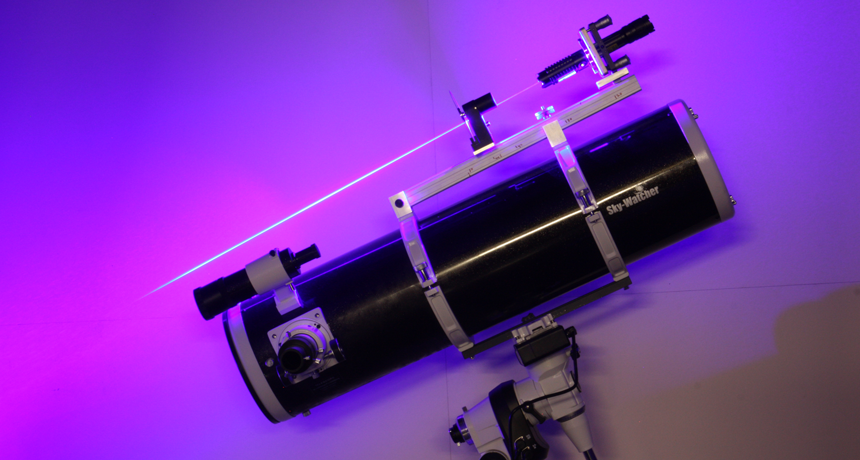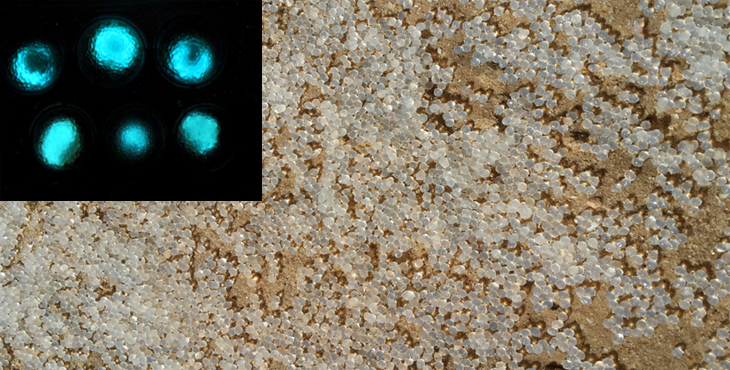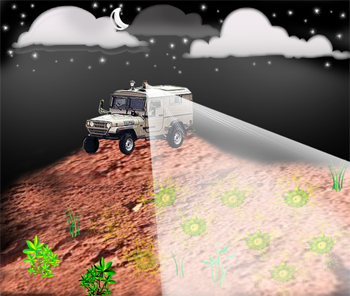Tweaked germs glow to pinpoint buried landmines
Scientists genetically engineered bacteria to find buried explosives

Laser beaming light (and telescope below to view fluorescence). This system is used to scout glowing bacteria that highlight the likely presence of buried landmines.
Hebrew University
By Dinsa Sachan
Landmines are explosive wartime weapons. People bury them or leave them on the ground for their enemies to step on or drive over. Yet once peacetime arrives, some of these buried bombs may remain behind. They’re often in empty fields, where they can maim or kill innocent civilians. But a new technology can make it easy to find landmines — even from a safe distance. And this might let bomb crews disarm these weapons before someone gets hurt.
The International Campaign to Ban Landmines (ICBL) is a group based in Geneva, Switzerland. It aims to end the use of these explosives. These mines had become such a big problem that an international Mine Ban Treaty was enacted in 1997. ICBL played a major role in getting countries to agree to the ban. For its success, ICBL and its coordinator — Jody Williams — shared the 1997 Nobel Peace Prize. Yet even today, millions of these bombs may still be buried out of sight across the world, according to the United Nations. In 2015 alone, the group notes, landmines and similar bombs killed or injured more than 5,000 civilians. Almost four in every 10 of the victims were children.
Trained workers typically go into a field with metal detectors to find and remove mines. But sometimes they don’t find the mines until they’re right on top of them, which can be very dangerous. That’s why the new technology is so promising. Using it, scouts now can identify landmines from a distance. Then they can send in experts to cautiously defuse or detonate the bombs.
Scientists described how their new system works April 11 in Nature Biotechnology.
Lasers and light-up germs
The research focused on what are called anti-personnel mines. Anti-personnel means these weapons have been set out to kill people: enemy soldiers. They explode when someone steps on them. (More powerful anti-tank mines, by contrast, are triggered only when heavier vehicles such as tanks or cars pass over them.)
Shimshon Belkin teaches biotechnology and environment sciences at the Hebrew University of Jerusalem in Israel. He knew that some microbes will happily eat and grow on particular pollutants. In his research, he has used these bacteria to find toxic chemicals.
“We demonstrated numerous times that we can engineer our bacterial sensors to detect and identify water pollutants,” he notes. His team recently challenged itself to use the same trick to find explosives. If they could get a microbe to interact with chemicals from the bombs, they might turn communities of the germs into little beacons. Essentially, the bacteria would say: “Here we are, and here are the explosives!”
Belkin’s team chose to make E. coli their beacons. Although this species of bacteria is common, it does not usually glow. So Belkin’s team inserted an extra gene into the bacteria. That gene lets the bacteria make a fluorescent protein. Fluorescence is when a substance absorbs light energy, then releases that energy again as a brief glow. The incoming light energy must be just the right color. To deliver the right color of light, Belkin’s team uses a laser.
Story continues below image.

The researchers put their genetically engineered germs into small beads. Then they sprayed the beads across a test field that was the size of a small swimming pool. Beneath the soil’s surface were 18 anti-personnel mines. This type of landmine generally contains an explosive material called trinitrotoluene (Try-NY-troh-TOLL-yu-een). It’s best known as TNT. This compound gives off gases that can get trapped in the soil directly above the landmines.
When the modified microbes encounter TNT vapors, they start making their fluorescent protein. The researchers pointed a laser and a telescope-like scanning instrument onto the field from 20 meters (nearly 66 feet) away. Wherever the bacteria had encountered TNT, they now glowed. In tests, this new system detected 13 of the 18 landmines. That’s almost three-quarters of them.
The technology is better than current mine-finding methods, but still a “work in progress,” Belkin says. It may not work in some areas. For example, it might not work where there are lots of trees blocking the path of the laser.
A promising start

Robert S. Burlage is a pharmacist at Concordia University Wisconsin in Mequon. He suggested using bacteria to find landmines 18 years ago. “It looks like they have a good start on the technology,” he now says of Belkin’s team. It’s also about time to try this in a real minefield, he adds.
Burlage says narrowing down the search area makes the bomb-finding process much safer overall. Once you know roughly where the mine is, you can use an ordinary metal detector to find it. That’s because “the mines all have itsy-bitsy pieces of metal, like springs,” he says. A metal detector can usually home in on these: “You just have to turn up [its] sensitivity and go very slowly.”
Michael Deyholos works in Canada at the University of British Columbia in Kelowna. He has modified the genes of plants to make them work as landmine detectors, too. So he’s familiar with the problem of tracking down these deadly leftovers of war. “There are tens of thousands of square kilometers that could potentially have mines,” he says. “So any technology that narrows down the search space is helpful.” He thinks the microbial method is encouraging, because “finding the mines is as much of a problem as deactivating them.”







